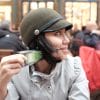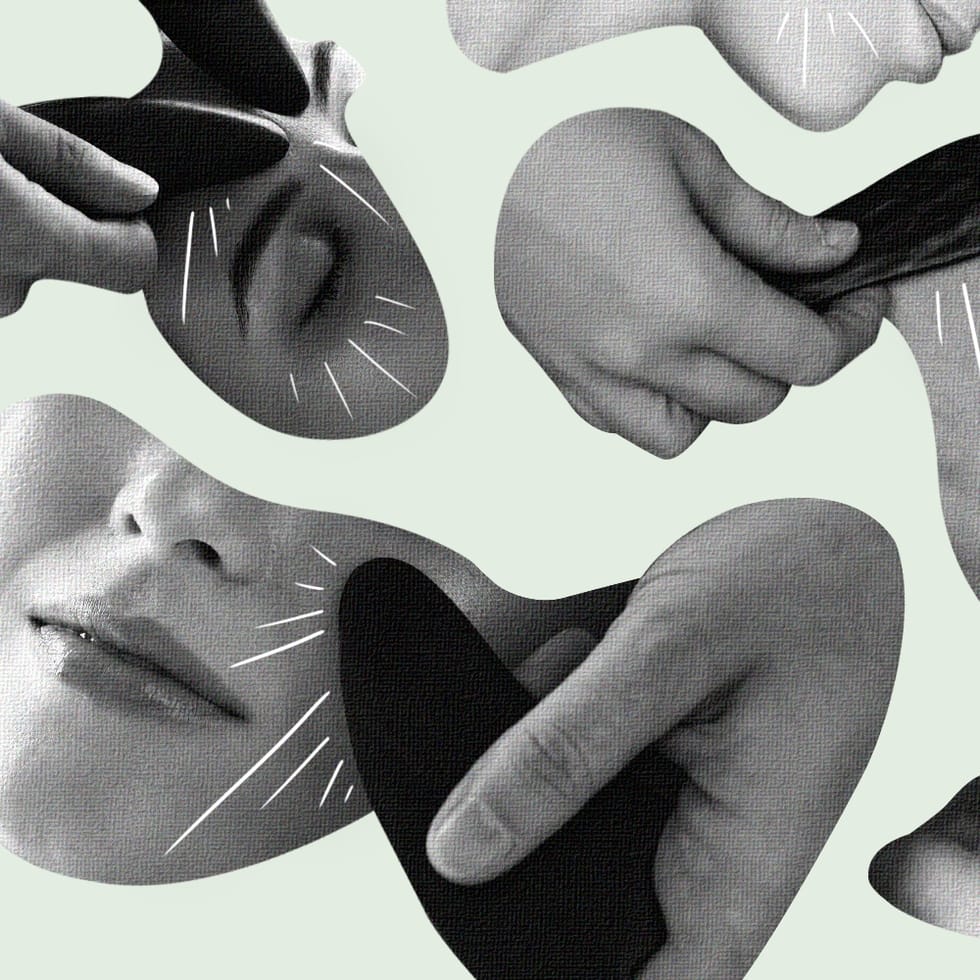
INGRID FRAHM GETTY IMAGES
When bride-to-be Danielle O’Brien broke out in stress hives as she prepared for her wedding, she knew she needed help. Like any bride, she wanted to look stunning and radiant on her big day; exhaustion had given her dark circles, and fine lines were creeping in. But after trying Botox in her twenties, O’Brien, now 31, was hesitant about resorting to injectables—the last thing the New Yorker wanted was to look unnatural in her wedding photos.
“Leading up to the wedding was absolutely crazy,” she recalls. “I wanted to the glow for the photos without having a frozen-looking face from Botox.”
Amidst the chaos of dress fittings, sending invitations, choosing music, and ordering the cake and flowers, O’Brien decided to try the needle-free healing treatment gua sha, a lo-fi ancient Chinese ritual that improves blood circulation, lymphatic drainage and skin elasticity, and addresses everything from adult acne to wrinkles to sagging skin. It was O’Brien’s regular visits to bespoke Manhattan salon Studio Britta, run by the cult facialist Britta Plug, that ultimately kept her calm, fixed her skin problems, and gave her that all-important bridal glow. “After seeing Britta, it all cleared up and I could still move my face; the fine lines are only there with dynamic movement,” she says.
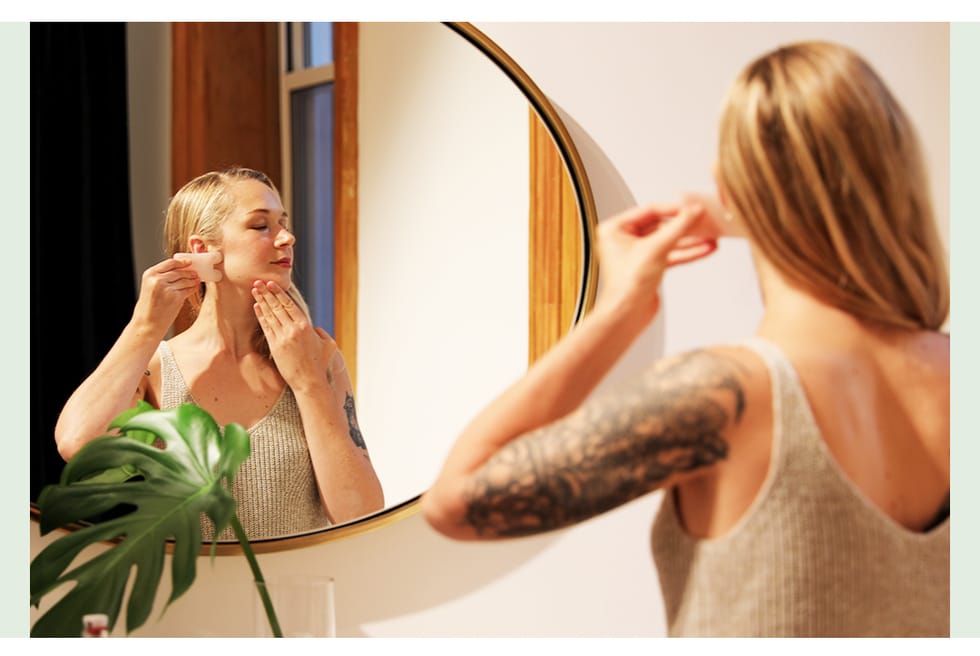
Britta Plug gives a demonstration of facial gua sha, which tones and lifts through gentle, upward strokes over the skin to relax stiff muscles and promote tissue drainage.
LINDSAY BILEZEKIAN
Gua sha stems from traditional Chinese medicine. To the casual observer, it can look fairly brutal, involving vigorous scraping of the skin all over the body with an angled, blunt-edge stone. The latest incarnation of the healing treatment, however, is a much gentler form and focuses solely on the face. Using a flat rose quartz tool, or in Plug’s case, a traditional Chinese bian smooth stone, facial gua sha tones and lifts the face through gentle, upward strokes over the skin to relax stiff muscles and promote tissue drainage.
Despite gua sha’s ancient origins, sculpting facials have become one of the hottest beauty trends in New York City over the last two years, as Western women with disposable income increasingly put a premium on promoting health and radiance from within. This new beauty fixation has seen Plug, a licensed aesthetician and holistic health coach with over 12 years of experience, expand her business into Manhattan from Brooklyn and recruit a team of nine to keep up with demand. A walking advertisement for her own treatments, many will recognize Plug—with her radiant, smooth, and soft-but-firm skin—from her YouTube videos, where she extolls the virtues of natural skincare techniques including Ayurvedic massage, as well as gua sha.
Her practice, says Plug, is all about celebrating individuality, not trying to conform to some unattainable standard where you don’t look like yourself. “No judgement if you want Botox—we all care about our physical appearance—but I want women to look like the most radiant version of themselves, not a clone,” Plug explains. “Gua sha is for women seeking solutions that take care of both body and mind—women who want an expression-smoothing alternative to the neurotoxins of Botox.”
First approved in 2002 for cometic use by the U.S. Food and Drug Administration, Botox (shorthand for Botulinum Toxin Type A, a neurotoxin known for causing botulism, an illness that paralyzes muscles and can be fatal) is considered safe as a temporary solution to wrinkles. However as with any drug, there are risks; possible side effects from Botox injections range from drooping eyelids and uneven eyebrows, to fatigue and double vision, to difficulty speaking and swallowing. Of the more than 1.1 billion people who used Botox in 2002, the FDA looked at 1,437 reports of adverse reactions and found that patients were more likely (33-fold higher) to report an adverse reaction after using Botox for therapeutic, rather than cosmetic use, “which may be related to higher doses, complicated underlying diseases, or both,” the report concluded. In 2009, the FDA added a safety warning which states Botox “may spread from the area of injection to produce symptoms of botulism,” including muscle weakness and difficulty breathing, which can occur hours or weeks after an injection.
For some women, a greater cause for concern in the lack of studies that focus on the long-term effects of Botox. One study published in 2005, which looked at 45 participants using Botox for both therapeutic and cosmetic reasons over the course of 12 years, found 30 percent of participants developed adverse reactions. A 2015 review of that study found the risk of adverse reactions increases after the 10th injection. There is also concern around how Botox affects the immune system. On a recent episode of The Paleo View podcast, medical biophysicist Dr. Sarah Ballantyne, PhD, notes that Botox can travel through the central nervous system and stimulate an inflammatory response in the immune system, which is the likely culprit of adverse reactions. “As I was researching this, I was very frustrated by the lack of long-term studies looking at whether or not the risk of adverse reactions compounds over time,” she explains. “I would have thought that would be necessary for FDA approval, but obviously it wasn’t.”
When migraine and TMJ sufferer Dr. Nikka Kanani started getting Botox injections for pain relief, she suffered nausea, numbness and tingling in certain areas of her face. “I never felt fully comfortable relying on Botox, especially because research on its long-term use is lacking,” admits the naturopathic doctor, who eventually stopped using the injectable neurotoxin, and with her background in integrative medicine, was relieved to find the natural gua sha treatments. By watching Plug’s video tutorials, Dr. Kanani has been able to practice the massage at home daily and stresses that consistency has helped her achieve the pain relief she was hoping for.
Similarly, Arielle Hayat, a clinical herbalist at The Alchemist’s Kitchen, has had tangible results since switching from Botox to gua sha nine months ago.
Hayat received regular Botox treatments twice a year for five years—and was cautiously optimistic before starting gua sha. While her fine lines haven’t disappeared completely, the deeper lines are less noticeable. “Right over the eyebrow, where you get a little line, a crease, those have softened,” she explains. “People tell me all the time, ‘You’re glowing, your skin is glowing! You’re so bright!’ It’s the same compliment I used to get when I got Botox.”
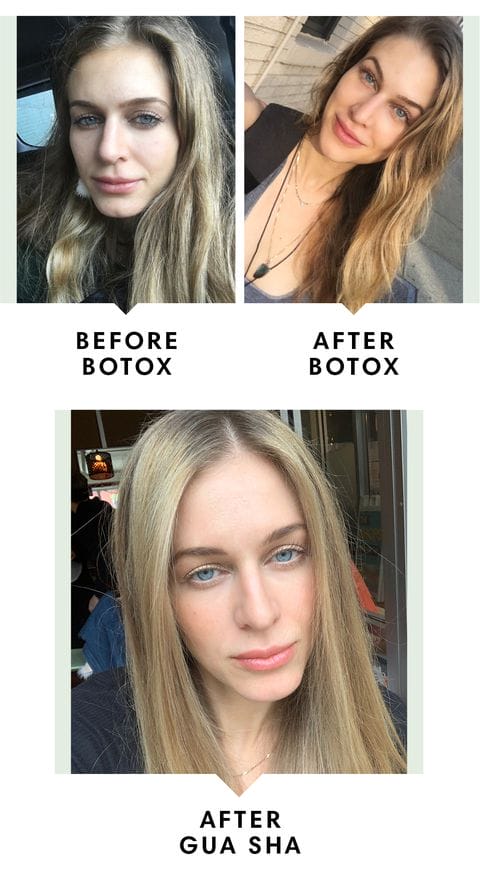
Arielle Hayat, a clinical herbalist, has had tangible results since switching from Botox to gua sha nine months ago. While her fine lines haven’t disappeared completely, the deeper lines are less noticeable.
For years, Hayat’s frown and forehead lines troubled her the most. “My wrinkles made it look like I was constantly in a bad mood,” she explains. “When I blow dry my hair, I raise my eyebrows; when I brush my teeth, I raise my eyebrows; when I put on mascara, I raise my eyebrows; and when I look at my phone, I make faces. I started to notice those faces were stuck on my face, even when they weren’t expressing my emotions.” Hayat now practices gua sha every day for three minutes. “That’s all I really have time for and I’ve noticed such a difference, specifically over my eyebrow.”
While it can take time, effort, and dedication to adopt a rigorous at-home gua sha routine, it’s essential for those wanting better, faster results, says Plug, who offers tutorials through the Wildling Beauty website and YouTube. Wildling Beauty, which Plug launched with plant alchemist Jill Munson and acupuncturist and herbalist Gianna De La Torre, aims to help women access the benefits of gua sha at home. Plants such as Balm of Gilead in its Empress oil and tonic, as well as a traditional Chinese bian stone tool, help clients sculpt and lift to reap rewards naturally.

The skin, being our largest organ, is inextricably tied to whole-body health. It’s what happens between facials—diet, exercise, stress, environment—that also affects our skin.
ALISSA LAURIE
Meanwhile in her Manhattan studio, creating the right environment to help clients find their inner beauty is paramount. On arrival, guests are offered licorice and burdock root Skin Tea from local company Masha Tea, before settling into the whimsical waiting area designed by Vincent Martinelli of Spatial Relations. Ambient sounds, such as those of U.S. electronic artist East Forest, play dreamily in the background of each treatment room, where guests often slip into a meditative state. But this is about more than just chilling out. Plug’s infrared Amethyst BioMat facial bed aims to reduce inflammation and help boost the immune system, kick-starting collagen production and cellular repair. Meanwhile the facial massage, with an emphasis on lymphatic drainage, offers what she calls an intensified re-patterning of habits in muscles and tissue, helping to remove metabolic waste, environmental pollution, and chemicals that may have entered into the body through conventional beauty products, tap water, or an overuse of plastic.
Gua sha also addresses the parasympathetic nervous system and can help with anxiety, stress, pain, and depression. (Botox, with its ability to inhibit negative expressions, is also seen as a possible treatment for depression, according to The Journal of Psychiatric Research.) “Many clients are women working their butts off in major careers with families, and who are experiencing rapid aging and adult acne,” Plug says. “We have to address the nervous system, because everything else is a band-aid. We’re offering an alternative for women who live holistically and want something that is in alignment with their values.”

Guests often slip into a meditative state during treatments at Studio Britta, helping to activate the parasympathetic nervous system which stimulates digestion, slows the heart rate, and promotes relaxation—a key to aging well.
LINDSAY BILEZEKIAN
Indeed, it seems gua sha devotees are happy to pay more for a natural alternative to skin care. While Botox, which lasts on average for three months, will set you back approximately $500 per visit, Plug’s Accelerated Clearing Series program starts at $1,590, followed by twice-monthly tune-ups for $135.
When it comes to looking good, Amy Abrams, the founder of Artists & Fleas, believes there really are no quick fixes, which is why she wanted to try gua sha over Botox. Within a year of starting monthly facials with Plug, the 46-year-old was delighted that a stubborn wrinkle above her eyes had faded considerably. “I’m not a super self-critical person, but when I saw worry lines becoming more pronounced in pictures, I thought maybe there was a way to do it naturally. I just want to look the best I can, and within a year I’ve definitely seen a reduction in the wrinkle.”
Another client, Allison Jacobs, who uses Botox occasionally, says gua sha is wonderful for women who prefer natural treatments, but she stresses the importance of committing to regular sessions. “It can soften lines if you do it every day,” she says. “It’s great facial stimulation.”
These days, bespoke, holistic services are not only the domain of small, independent specialists such as Britta Plug. With five shops in New York and two in California, skincare chain Heyday offers a range of personalized facials (including a hemp-derived CBD service in Los Angeles) and has a philosophy of being progressive, not aggressive, with its products and treatments.
Heyday chief brand officer and co-founder Michael Pollak believes the industry is trending in the right direction, with customers demanding more transparency and integrity around words such as “natural” and “organic”. He says skincare experiences in 2019 are about much more than mere pampering. “When we started Heyday, we expressly chose not to use the word ‘spa’ to describe ourselves, or ‘pampering’ to talk about facials. We have nothing against spas and fully believe you’ll feel pampered and cared for in a facial. But what you’re truly receiving is time with an expert for their advice and their human touch.”
As for the holistic approach, Pollak points out that the skin, being our largest organ, is inextricably tied to whole-body health. While they can get excellent work done in a facial, it’s what happens between facials—diet, exercise, stress, environment—that affects our skin.
His words are echoed by Dr. Jessica Weiser from New York Dermatology Group, who says proper skin care involves many steps. Dr. Weiser explains that the trend towards ancient Eastern skincare routines, such as gua sha and Ayurveda, reflects a growing interest in more natural lifestyles and can certainly assist with skin vibrancy and clarity. “These routines encourage the elimination of chemicals from the body and the skin specifically,” notes Dr. Weiser, who encourages all her patients to take care of their skin between facial treatments. “The treatments require frequent repetition and can help contribute to a comprehensive skin routine.”
Marina Helms, who follows Plug’s skincare tips on Instagram, echoes this sentiment. Based in Brazil, Helms began practicing gua sha five times a week after discovering Plug’s online tutorials. And while it took several weeks to notice a difference on fine lines, she says the results on puffiness and tension were instant. “It has opened up my eyes, defined my jaw line, and helped on skin quality,” says Helms, adding that “the real results come from taking care and loving my skin consistently at home.”
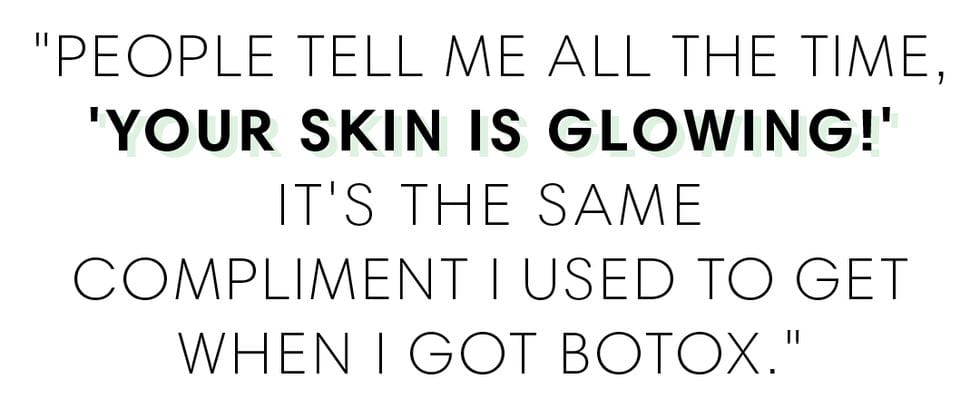
Last year, 27-year-old Helms ditched her dermatologist’s advice to use Botox to lift her eyebrows and stop wrinkles. “The feeling of not moving your face was the worst for me, it made me feel weird. I felt trapped in some way; the blockage in my face made me feel like my energy couldn’t flow there,” she explains. Despite the popularity of Botox, which Helms first tired at 23, she soon realized that it was a shame to freeze her own expressions of happiness, sadness, or any feelings just to be ‘pretty’ in a picture. “Then my friends and family started telling me that I didn’t look like myself anymore; my cheeks were in a different place,” she laughs. “Now, I still get to move my face and have natural expression lines.”
Plug says she is concerned about young women who start injections early. “I strongly suspect we’ll be seeing more research on how long-term use of an injected neurotoxin affects the nervous system and brain in unintended way,” she warns.
Despite having tried Botox in her twenties, Danielle O’Brien is adamant she won’t be tempted to do injections again. Since her wedding last September, she has continued to visit Plug regularly to help rejuvenate her skin and promote overall health.
“I love that you go into a meditative state which helps with healing,” she says. “It’s a place for me to calm down and not be on my phone. It fixes the big circles under my eyes, de-puffs my skin, and I can still move my face!”

INGRID FRAHM GETTY IMAGES



